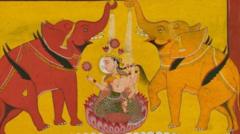A new exhibition at the British Museum in London, entitled *Ancient India: Living Traditions*, provides a remarkable insight into the evolution of India's spiritual art by showcasing 189 exquisite objects that span centuries. Visitors will find a diverse array of pieces, including 2,000-year-old sculptures and paintings, intricate narrative panels, and manuscripts that together illustrate the profound progression of spiritual expression in India.
The period between 200 BC and AD 600 marked a significant transformation in the artistic portrayal of divine figures across the Indian subcontinent, with representations moving from heavily symbolic depictions to more recognizable human forms. Sushma Jansari, the exhibition's curator, notes that the shared cultural roots of Hinduism, Buddhism, and Jainism, which included the worship of ancient nature spirits, underwent dramatic changes in religious iconography during this pivotal time that resonates even today.
The exhibition is carefully organized into five sections, beginning with nature spirits and followed by subsections dedicated to each religion. It concludes with a look at how these faiths and their artistic expressions spread beyond India, reaching countries like Cambodia and China. The centerpiece of the Buddhist section features a striking two-sided sandstone panel that exemplifies the evolution of the Buddha's imagery, showcasing a stark contrast between symbolic representations of the Buddha in an earlier phase and its human depiction carved later.
In the Hindu section, a remarkable bronze statue illustrates the gradual progression of sacred imagery, depicting a yakshi—a natural spirit associated with fertility—while also hinting at the future representation of female deities in the Hindu tradition. Jain religious art in the exhibition focuses on tirthankaras, the 24 enlightened teachers, with one particular sandstone piece tracing back to AD 200-300—their earliest representations characterized by specific sacred symbols.
The exhibition is unique as it examines the artistic origins of all three religious traditions together, rather than in isolation, making it a groundbreaking endeavor. The provenance of each artifact has been meticulously documented, revealing the journey of each piece through various hands, including the notable contributions of women in the donation of Buddhist art.
While the transformative nature of visual language remains a topic of scholarly debate, the exhibition aims to evoke the spiritual atmosphere of religious shrines. Engaging multisensory experiences like scents, sounds of nature, and vibrant colors enhance the exhibit's depth, highlighting the ongoing relevance of these ancient traditions in contemporary practice.
*Ancient India: Living Traditions* runs at the British Museum from May 22 to October 19. It draws upon the museum's extensive South Asian collection, supplemented by loans from private collectors and institutions worldwide, ensuring a rich portrayal of the historical and cultural significance of India's spiritual art.






















